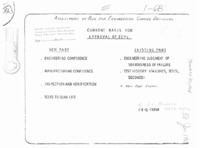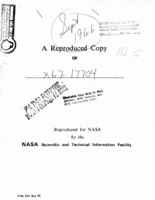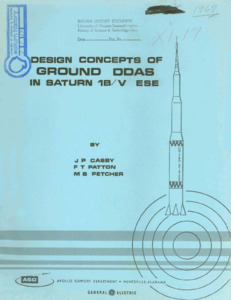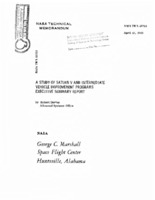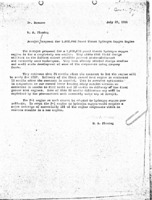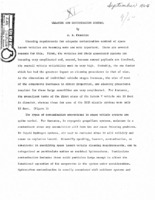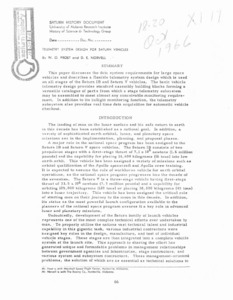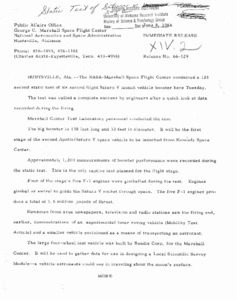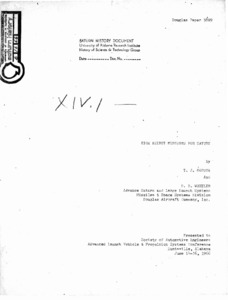
Browse Items (44 total)
Sort by:
-
Differences of configuration in successive Saturn IB and Saturn V vehicles- case 330.
Includes memorandum for file. Configuration matrices reflecting present program status of differences in Saturn IB and Saturn V flight hardware on a mission to mission basis have been prepared. The attached matrices are arranged to show differences in major subsystems (Structures, Propulsion, Instrumentation and Range Safety, and Electrical) for each stage. The reason for the configuration difference and the mission effectivity are included.; DMD, 2031-SGE-eas, GRH; Includes "Recommendation for announcement and distribution of Bellcomm Report". -
"Assessment of Risk for Engineering Change Decisions."
This document includes the current basis for approval of ECPs, fatigue life after stress reduction, and other probability and comparative risk assessments. On the first page there is an inscription, "By E.L. Bombara NASA-MSFC." -
"Application of the Saturn V Launch Vehicle to Unmanned Scientific Exploration of the Solar System."
According to the foreword, "This paper presents the results of a twelve-week mission and systems analysis of a combined Jupiter orbiter/solar probe mission utilizing the Saturn V launch vehicle." -
"Design Concepts of Ground DDAS in Saturn 1B/V ESE."
In the Saturn IB/V programs the sheer quantity of data required for computer processing and ESE display makes it necessary to provide an efficient data acquisition system. For much of the data originating in the launcher this requirement is satisfied by the Ground Digital Data Acquisition System (DDAS). This paper provides a technical description of the Ground DDAS with emphasis placed on the unique design concepts of this telemetry system. -
"A Study of Saturn V and Intermediate Vehicle Improvement Programs Executive Summary Report."
The abstract notes, "The purpose of this report is to summarize the results of three companion studies designed to investigate both the performance growth potential of the Saturn V and the utilization of Saturn V equipment to fill the performance gap in the intermediate payload range between the Saturn IB and the Saturn V. This report includes significant data which is intended to aid the planning of future missions. This data reflects some of the various vehicle configurations which can be used by mission planners to satisfy payload desires in excess of the Saturn IB and Saturn V." -
"Cleaning and Contamination Control."
The document is a paper describing contamination cleaning methods and advocating for further developments in the field. Tables and figures are included at the end of the paper. The figures include a comparison of Saturn V with Saturn I and Saturn IB and cross-sections of the Saturn C-5, S-IC stage fuel tank assembly and oxidizer tank assembly. -
"Telemetry system design for Saturn vehicles."
This paper discusses the data system requirements for large space vehicles and describes a flexible telemetry system design which is used on all stages of the Saturn IB and Saturn V vehicles. The basic vehicle telemetry design provides standard assembly building blocks forming a versatile catalogue of parts from which a stage telemetry subsystem may be assembled to meet almost any conceivable monitoring requirement. In addition to its inflight monitoring function, the telemetry subsystem also provides real time data acquisition for automatic vehicle checkout. -
"Static test of Saturn V S-IC : news release.
Report after second Saturn V flight test. -
"High Energy Missions for Saturn."
Presented to Society of Automotive Engineers, Advanced Launch Vehicle & Propulsion Systems. When the Apollo lunar landing project is complete, the Saturn and Apollo hardware will only have begun to realize their ultimate potential for space exploration. The immense reserve of Apollo technology, facilities, and booster capability can then be directed to the achievement of national goals which lie far beyond the initial lunar landing. In achieving the Apollo lunar objectives, large investments will have been made in launch facilities, tracking systems, propulsion techniques, reentry systems, lunar landing systems and rendezvous technologies. Although developnent in these specialized areas has been tailored to the needs of Apollo, numerous studies by NASA and industry have demonstrated the feasibility of using the spacecraft, launch vehicles, and operating techniques for missions far more complex than lunar landings. Amortization of this hardware will prove cost-effective for missions of more sophisticated applications.

